Longan
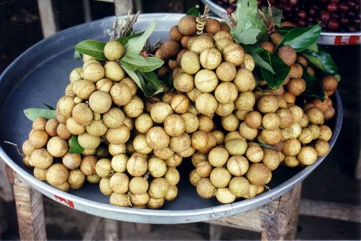
A tropical plant. It will grow in poorer soils and colder conditions than a litchi. It can stand frost and needs a period of cool temperature to fruit well. So they suit a subtropical to warm temperate climate, but will also grow in the lowland tropics. The chilling requirement is less than litchi which means it will fruit in more tropical areas. It does best with temperatures between 19-26°C. They can tolerate wind but drying winds at flowering affect fruit set. Excessive rainfall during flowering reduces fruit set. It suits monsoonal regions with a distinct wet and dry season. They can tolerate flooding for a few days. A rainfall of 1,500-2,000 mm is best. A pH of 4.5-6 is best. In XTBG Yunnan. It suits hardiness zones 11-12.
Also known as:
Arem litchi, Ashphal, Bambo, Buku, Chempoovam, Dieng-loba, Diengloba, Dopar, Dragon's eye, Ga-naing-gyo, Ihau, Kanakindeli, Kath lichu, Kelengkeng, Laam-yai, Lam-yai, Lamyai, Lengkeng, Long yean gan, Longana, Longyan, Loong narn, Lungan, Mahau, Malakcota, Mamoncillo chino, Marli, Mata kuching, Meanprey, Mien, Mirgoch, Mora, Mulei, Naga lichu, Nagalichi, Nhan, Nurai, Olho-de-dragao, Pasakotta, Peni mora, Pohon lengkeng, Poripuna, Puvatti, Rongan, Rupai, Ryugan, Shempuna, Shempuvan, Takuhis, Tating jala, Taw-kyetmauk, Taw-longan, Tayok-kyetmauk, Tegonog, Theifei-mung, Tokra, Umb, Vumb, Wumb
Synonyms
- Euphoria cinerea (Turcz.) Radlk.
- Euphoria gracilis Radlk.
- Euphoria longan (Lour.) Steud.
- Euphoria longana Lam.
- Euphoria malaiensis (Griff.) Radlk.
- Euphoria microcarpa Radlk.
- Euphoria verruculosa Salisb.
- Nephelium longan (Lour.) Hook.
- Nephelium longana (Lam.) Cambess.
- Nephelium long-yan Blume
- Nephelium malaiensis Griff.
- Pometia curtisii King
- Sapindus cinereus Turcz.
Edible Portion
- Fruit, Leaves - tea, Seeds
Where does Longan grow?
Found in: Asia, Australia, Bangladesh, Bermuda, Brazil, Cambodia, China, Cook Islands, Cuba, East Timor, Guam, Hawaii, Himalayas, India, Indochina, Indonesia, Jamaica, Laos, Malaysia, Mauritius, Myanmar, North America, Northeastern India, Pacific, Pakistan, Papua New Guinea, PNG, Philippines, Puerto Rico, Reunion, SE Asia, Singapore, South America, Sri Lanka, Taiwan, Thailand, Timor-Leste, United States, Vietnam
Notes: There are 6 Dimocarpus species. Fruit are high in folates 68μg/100.
Status: It is a cultivated food plants. The fruit are sold in local markets.
Growing Longan
Cultivation: Seedlings do not produce true to type and take up to 20 years to fruit. So air layered or grafted plants are used and these fruit in 3-4 years. For air layering, mature shoots about 2-3 cm across are chosen which do not have active vegetative growth. A ring is cut around the twig 50 cm from the tip removing the bark and soft wood. A plastic sleeve is put over the twig and tied below the cut ring. Then peat moss or rooting mix is filled into the sleeve and this is tied off above the ring. When roots have formed the twig is cut off and planted. Cuttings and budding can also be used. Spacing needs to be 5-8 m apart. Deep rooting needs to be encouraged by good site preparation. This stops trees being blown over. Wind protection is essential. Although flowers need to be cross pollinated, this can be done between flowers on the same tree as flowers develop at different times. Very little pruning should be done. Fruit need to ripen on the tree. They do not ripen further after harvest.
Edible Uses: The fruit is eaten raw or cooked. They can be dried and stored or preserved canned in syrup.
Production: Seedlings grow slowly at first, but then grow more rapidly. Trees fruit after 7-10 years from seed and 3-5 years from vegetative plants. Up to 40 to 55 kg of fruit per tree are possible. Fruit mature in 120-150 days. Fruit can be stored for 6 weeks at 5°C when covered. Trees can live for 400 years.
Nutrition Info
per 100g edible portion| Edible Part | Energy (kcal) | Protein (g) | Iron (mg) | Vitamin A (ug) | Vitamin c (mg) | Zinc (mg) | % Water |
|---|---|---|---|---|---|---|---|
| Fruit - raw | 61 | 1.3 | 1.2 | - | 84 | 0.1 | 82 |
Longan Photos

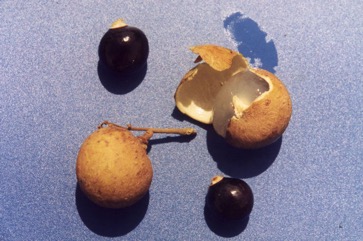
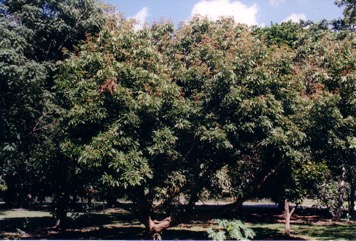
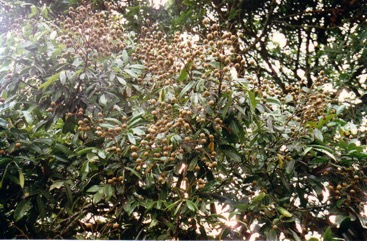
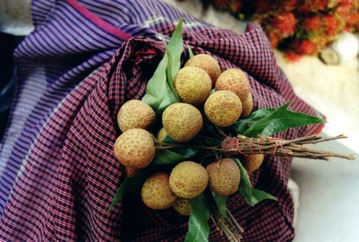
References
Longan references Euphoria longan/Dimocarpus
AAK, 1980, Bertanam Pohon Buah-buahan. Penerbitan Yayasan Kanisius, Jogyakarta. p 69
Alexander, D.M., Scholefield, P.B., Frodsham, A., 1982, Some tree fruits for tropical Australia. CSIRO, Australia. p 33
Ambasta, S.P. (Ed.), 2000, The Useful Plants of India. CSIR India. p 214 (As Euphoria longan)
Anderson, E. F., 1993, Plants and people of the Golden Triangle. Dioscorides Press. p 209
Argent, G et al, nd, Manual of the Larger and More important non Dipterocarp Trees of Central Kalimantan Indonesia. Volume 2 Forest Research Institute, Samarinda, Indonesia. p 556
Arora, R. K., 2014, Diversity in Underutilized Plant Species - An Asia-Pacific Perspective. Bioversity International. p 66
Ashton, M. S., et al 1997, A Field Guide to the Common Trees and Shrubs of Sri Lanka. WHT Publications Ltd. pdf p 356
Backer & Bakh. f. 1963-1968. Flora of Java.
Bajpai, O., et al, 2015, Tree species of the Himalayan Terai region of Uttar Pradesh, India: a checklist. Check List 11(4): 1718
BARC, 2016, State of Biodiversity for Food and Agriculture in Bangladesh. Bangladesh Agricultural Research Council.
Barwick, M., 2004, Tropical and Subtropical Trees. A Worldwide Encyclopedic Guide. Thames and Hudson p 146
Banerjee, A., et al, 2013, Ethnobotanical Documentation of Some Wild Edible Plants in Bankura District, West Bengal, India. The Journal of Ethnobiology and Traditional Medicine. Photon 120 (2013) 585-590
Bodkin, F., 1991, Encyclopedia Botanica. Cornstalk publishing, p 465
Burkill, I.H., 1966, A Dictionary of the Economic Products of the Malay Peninsula. Ministry of Agriculture and Cooperatives, Kuala Lumpur, Malaysia. Vol 2 (I-Z) p 1573 (As Nephelium longana)
Castillo, C., 2013, The Archaeobotany of Khao Sam Kaeo and Phu Khao Thong: The Agriculture of Late Prehistoric Southern Thailand. Ph. D. thesis University College, London p 379 (As Euphoria longana)
Chai, P. P. K. (Ed), et al, 2000, A checklist of Flora, Fauna, Food and Medicinal Plants. Lanjak Entimau Wildlife Sanctuary, Sarawak. Forestry Malaysia & ITTO. p 170
Chandrashekara, U. M., 2009, Tree species yielding edible fruit in the coffee-based homegardens of Kerala, India: their diversity, uses and management. Food Sec. 1:361-370
Coronel, R.E., 1982, Fruit Collections in the Philippines. IBPGR Newsletter p 6 (As Euphoria longana)
Cundall, P., (ed.), 2004, Gardening Australia: flora: the gardener's bible. ABC Books. p 501
Das, S. and De, B., 2013, Evaluation of Angiotension I-Converting Enzyme (ACE) inhibitory potential of some underutilized indigenous fruits of West Bengal using an in vitro model. Fruits, Vol. 68:499-506 (As Nephelium longana)
Darley, J.J., 1993, Know and Enjoy Tropical Fruit. P & S Publishers. p 61 (As Euphoria longan)
Encke, F., et al. 1984. Zander: Handworterbuch der Pflanzennamen, ed. 13.
Engel, D.H., & Phummai, S., 2000, A Field Guide to Tropical Plants of Asia. Timber Press. p 47 (As Euphoria longan)
Etherington, K., & Imwold, D., (Eds), 2001, Botanica's Trees & Shrubs. The illustrated A-Z of over 8500 trees and shrubs. Random House, Australia. p 263
Facciola, S., 1998, Cornucopia 2: a Source Book of Edible Plants. Kampong Publications, p 224
Flora of China. www.eFloras.org
Fl. cochinch. 1:233. 1790
Food Composition Tables for use in East Asia FAO http://www.fao.org/infoods/directory No. 901
Gardner, S., et al, 2000, A Field Guide to Forest Trees of Northern Thailand, Kobfai Publishing Project. p 135
Gouldstone, S., 1983, Growing your own Food-bearing Plants in Australia. Macmillan p 104 (As Euphoria longana)
Hedrick, U.P., 1919, (Ed.), Sturtevant's edible plants of the world. p 435 (As Nephelium longana)
Hibbert, M., 2002, The Aussie Plant Finder 2002, Florilegium. p 87
Hu, Shiu-ying, 2005, Food Plants of China. The Chinese University Press. p 523
INFOODS:FAO/INFOODS Databases
Jadhav, R., et al, 2015, Forest Foods of Northern Western Ghats: Mode of Consumption, Nutrition and Availability. Asian Agri-History Vol. 19, No. 4: 293-317
Jin, Chen et al, 1999, Ethnobotanical studies on Wild Edible Fruits in Southern Yunnan: Folk Names: Nutritional Value and Uses. Economic Botany 53(1) pp 2-14
Johns, L.& Stevenson,V., 1979, The Complete Book of Fruit. Angus and Robertson. p 180
Kar, A., et al, 2013, Wild Edible Plant Resources used by the Mizos of Mizoram, India. Kathmandu University Journal of Science, Engineering and Technology. Vol. 9, No. 1, July, 2013, 106-126
Khan, D. & Shaukat, S.S., 2006, The Fruits of Pakistan: Diversity, Distribution, Trends of Production and Use. Int. J. Biol. Biotech., 3(3):463-499
Kiple, K.F. & Ornelas, K.C., (eds), 2000, The Cambridge World History of Food. CUP p 1803
Lalfakzuala, R., 2007, Ethnobotanical usages of plants in western Mizoram. Indian Journal of Traditional Knowledge. Vol 6(3) pp 480-493 (As Euphoria longan)
Leenh. 1971. Blumea 19:122.
Lembaga Biologi Nasional, 1977, Buah-Buahan, Balai Pustaka, Jakarta. p 80
Liberty Hyde Bailey Hortorium. 1976. Hortus third.
Llamas, K.A., 2003, Tropical Flowering Plants. Timber Press. p 341
Lorenzi, H., Bacher, L., Lacerda, M. & Sartori, S., 2006, Brazilian Fruits & Cultivated Exotics. Sao Paulo, Instituto Plantarum de Estuados da Flora Ltda. p 607
Lyle, S., 2006, Discovering fruit and nuts. Land Links. p 178
Martin, F. W., et al, 1987, Perennial Edible Fruits of the Tropics. USDA Handbook 642 p 56 (As Euphoria longana)
McMakin, P.D., 2000, Flowering Plants of Thailand. A Field Guide. White Lotus. p 109 (As Euphoria longan)
Menzel, C., Watson, B., and Simpson, D., Longan (Euphoria longan ). The Australian New Crops Newsletter. 4. July. 1995
Miguel, E., et al, 1989, A checklist of the cultivated plants of Cuba. Kulturpflanze 37. 1989, 211-357
Morton, J. F., 1987, Fruits of Warm Climates. Wipf & Stock Publishers p 259
Mozhui, R., et al, 2011, Wild edible fruits used by the tribals of Dimapur district of Nagaland, India. Pleione 5(1): 56 - 64. (As Nephelium longana)
Pasha, M. K. & Uddin, S. B., 2019, Minor Edible Fruits of Bangladesh. Bangladesh J. Plant Taxon. 26(2): 299–313
Patiri, B. & Borah, A., 2007, Wild Edible Plants of Assam. Geethaki Publishers. p 29
Paul, A., 2013, Minor and uncultivated fruits of Eastern India, 2nd International Symposium on Minor Fruits and Medicinal Plants (As Euphoria longan)
Peekel, P.G., 1984, (Translation E.E.Henty), Flora of the Bismarck Archipelago for Naturalists, Division of Botany, Lae, PNG. p 341
Pegu, R., et al, 2013, Ethnobotanical study of Wild Edible Plants in Poba Reserved Forest, Assam, India. Research Journal of Agriculture and Forestry Sciences 1(3):1-10 (As Euphoria longan)
Phon, P., 2000, Plants used in Cambodia. © Pauline Dy Phon, Phnom Penh, Cambodia. p 234
PROSEA (Plant Resources of South East Asia) handbook, Volume 2, 1991, Edible fruits and nuts.
Rajapaksha, U., 1998, Traditional Food Plants in Sri Lanka. HARTI, Sri Lanka. p 446 (As Euphoria longana)
Recher, P, 2001, Fruit Spirit Botanical Gardens Plant Index. www.nrg.com.au/~recher/ seedlist.html p 2 (As Euphoria longana)
Sawian, J. T., et al, 2007, Wild edible plants of Meghalaya, North-east India. Natural Product Radiance Vol. 6(5): p 419 (As Nephelium longana)
Schubert, B. G., 1975. Taxon 24:173.
Sharma, B.B., 2005, Growing fruits and vegetables. Publications Division. Ministry of Information and broadcasting. India. p 83 (As Euphoria longan)
Slik, F., www.asianplant.net
Solomon, C., 2001, Encyclopedia of Asian Food. New Holland. p 222
Sukarya, D. G., (Ed.) 2013, 3,500 Plant Species of the Botanic Gardens of Indonesia. LIPI p 231
Suwardi, A. B., et al, 2020, Ethnobotany and conservation of indigenous edible fruit plants in South Aceh, Indonesia. Biodiversitas Vol. 21, No. 5, pp 1850-1860
Tankard, G., 1987, Tropical fruit. Viking. p 60
Tate, D., 1999, Tropical Fruit. Archipelago Press. Singapore. p 54
Terrell et al. 1986. Agric. Handb. no. 505.
Thitiprasert, W., et al, 2007, Country report on the State of Plant Genetic Resources for Food and Agriculture in Thailand (1997-2004). FAO p 95
Thomson, G. & Morgan, W., (Ed.) 2004, Access to Asian Foods Newsletter, Vic Govt., Australia Issue 70
Turreira Garcia, N., et al, 2017, Ethnobotanical knowledgeof the Kuy and Khmer people in Prey Lang, Cambodia. Cambodian Journal of Natural History 2017 (1): 76-101
Valder, P., 1999, The Garden Plants of China. Florilegium. p 279
van Wyk, B., 2005, Food Plants of the World. An illustrated guide. Timber press. p 176
Walker, E., 1976. Flora of Okinawa and the southern Ryukyu Islands.
Dimocarpus Cull, B.W., 1995, Fruit Growing in Warm Climates. Reed. p 170
Forest Inventory and Planning Institute, 1996, Vietnam Forest Trees. Agriculture Publishing House p 650
Lazarides, M. & Hince, B., 1993, Handbook of Economic Plants of Australia, CSIRO. p 81
Macmillan, H.F. (Revised Barlow, H.S., et al) 1991, Tropical Planting and Gardening. Sixth edition. Malayan Nature Society. Kuala Lumpur. p 279
Singh, H.B., Arora R.K.,1978, Wild edible Plants of India. Indian Council of Agricultural Research, New Delhi. p 59
Smith, K., 1998. Growing Uncommon Fruits and Vegetables. New Holland. p 87
Staples, G.W. and Herbst, D.R., 2005, A tropical Garden Flora. Bishop Museum Press, Honolulu, Hawaii. p 512 (Drawing)
Striegel, L., et al, 2019, Promising Tropical Fruits High in Folates. Foods 2019, 8, 363; doi:10.3390/foods8090363. www.mdpi.com/journal/foods
USDA, ARS, National Genetic Resources Program. Germplasm Resources Information Network - (GRIN). [Online Database] National Germplasm Resources Laboratory, Beltsville, Maryland. Available: www.ars-grin.gov/cgi-bin/npgs/html/econ.pl (10 April 2000)
Wild edible plants of Himachal Pradesh (As Euphoria longana)
World Checklist of Useful Plant Species 2020. Royal Botanic Gardens, Kew
www.worldagroforestrycentre.org/treedb/